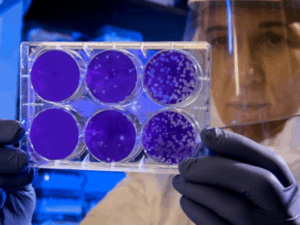12 June 2020
In an era of drones, self-driving cars and 3D printing, biomedical research remains heavily rooted in methods of the past — namely, animal models and animal-derived tissues. This remains true even as the field of toxicology begins to shift from a near-total reliance on live animals toward human-based cell systems and other technologies.
In the context of the “3Rs” of replacement, reduction and refinement of animal use, in vitro methods are often assumed to be non-animal. But this is not necessarily so. In vitro cultures and associated modalities commonly use animals as a source of biological materials, even when relying primarily on human-derived cells and tissues.
To raise awareness about the source of cell culture materials, I recently worked with other scientists to systematically review in vitro methods developed to replace animal testing for skin sensitization. We found 83 different in vitro methods based on human and animal cells designed to assess the potential and/or potency of skin sensitizers. Despite aiming to replace animal testing, these methods draw upon a multitude of animal-derived products, including animal cells (primary cells and cell lines), skin explants, sera, bovine serum albumin, trypsin, heparin and collagen. These findings indicate that many methods frequently held up as “non-animal” do not, in fact, fully replace animals in safety assessment. The use of animal-derived materials is not only an ethical issue for consumers who rely on cruelty-free assurances. It has ethical and technical implications for safety assessment and biomedical research, too.
Seventy-eight percent of the methods identified in our review used fetal bovine serum, a common culture medium supplement containing growth factors, hormones, vitamins, transport proteins and other elements. FBS has been used to stimulate cellular growth in vitro since the late 1950s. However, its use has ethical implications,  as the methods to harvest blood from unborn calves (left) may lead to pain and/or distress. There are also scientific disadvantages to using FBS, including but not limited to: significant differences in the fluid to which cells are exposed in their natural environment; an unknown exact composition, which can lead to unintended interactions; potential contaminants, such as endotoxins, mycoplasma, virus and prions; and substantial lot-to-lot variability with geographical and seasonal supply changes, which can lead to lack of consistency and standardization of the methods/models. In addition, the price of FBS inevitably fluctuates due to its commodity nature.
as the methods to harvest blood from unborn calves (left) may lead to pain and/or distress. There are also scientific disadvantages to using FBS, including but not limited to: significant differences in the fluid to which cells are exposed in their natural environment; an unknown exact composition, which can lead to unintended interactions; potential contaminants, such as endotoxins, mycoplasma, virus and prions; and substantial lot-to-lot variability with geographical and seasonal supply changes, which can lead to lack of consistency and standardization of the methods/models. In addition, the price of FBS inevitably fluctuates due to its commodity nature.
In recent years, reagent companies have developed many alternatives to animal-derived products. For example, FBS can now be replaced by human serum, human platelet lysate and serum-free media. The Organization for Economic Cooperation and Development recently recommended the use of serum-free media in its 2018 “Guidance Document on Good In Vitro Method Practices” , aimed at defining standards to ensure the rigor and reproducibility of data from in vitro methods. Commercial availability of alternatives to other commonly used products also continues to grow. For example, the in vivo production of monoclonal antibodies using ascites can (and should) now be fully replaced by in vitro methods, recombinant or synthetic antibodies. In fact, in vitro methods can be, and successfully have been, adapted to be completely free of animal products, in response to demands from stakeholders in the cosmetics and chemical industries.
If the ultimate aim of the 3Rs — i.e., full replacement — is ever to be achieved, we must fully embrace and invest in modern, human-based approaches and technologies. Experience and observation confirm that such approaches can enable a dynamic systems-level, human-specific understanding of the pathophysiology of human diseases. This must go hand in hand with ending our reliance on animals as sources of reagents. Together, we can make the vision of a cruelty-free science a real one. But we must work harder if we are to succeed.
What do you think? Please share your thoughts and comments below.
 by
by 

Post a comment